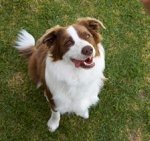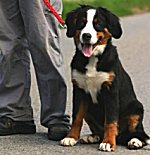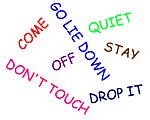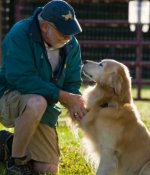Polish Lowland Sheepdogs: What's Good About 'Em, What's Bad About 'Em
Polish Lowland Sheepdog temperament, personality, training, behavior, pros and cons, advice, and information, by Michele Welton, Dog Trainer, Behavioral Consultant, Author of 15 Dog Books
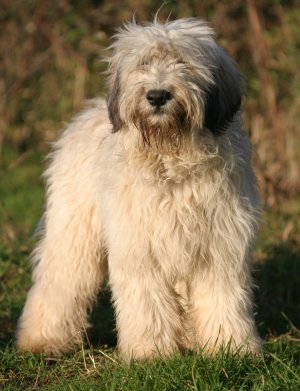
The Polish Lowland Sheepdog (nicknamed PON from his official Polish name "Polish Owczark Nizinny") is a lively working dog. Strong and durable, athletic and agile, he requires daily exercise and does best with active outdoorsy owners.
Mental stimulation in the form of advanced obedience classes, agility classes, or herding livestock, is even more important to this intelligent breed.
When these needs are met, the Polish Lowland Sheepdog is calm and stable and settles down happily indoors.
Somewhat aloof and suspicious of strangers, the PON makes a vigilant watchdog. In fact, socialization must be early and thorough so that his watchfulness does not sharpen into suspiciousness or shyness.
Most Polish Lowland Sheepdogs are dominant toward other dogs, especially of the same sex. Those with a high prey drive are not reliable around little creatures that run or flutter.
These confident dogs were bred to think independently and make their own decisions, and they will do exactly that unless you take charge and establish the rules. They are persistent problem-solvers ("If I can't get what I want this way, maybe I can get it this way.") and can be dominant and manipulative. Not a good breed for a novice owner.
Nor is this rustic (shaggy) breed a good choice for the immaculate household. Mud, snow, and leaves cling to his tousled coat, and his beard collects water and food remnants and can become matted and smelly.
If you want a dog who...
- Is medium-sized and natural-looking
- Is an enthusiastic working dog who thrives on vigorous exercise and challenging activities
- Is calm indoors (with enough exercise)
- Makes a vigilant watchdog
A Polish Lowland Sheepdog may be right for you.
If you don't want to deal with...
- Vigorous exercise requirements
- Destructiveness when bored or not exercised enough
- Suspiciousness toward strangers when not socialized enough
- Potential aggression toward other animals
- Strong-willed mind of his own, requiring a confident owner who can take charge
- Lots of brushing and combing (or clipping the coat short)
- "Shaggy dog syndrome," i.e. debris clinging to the coat, water soaking into the beard and dripping on your floors
- Waiting lists (hard to find) and a high price tag
A Polish Lowland Sheepdog may not be right for you.
 |
Dog Breed Traits – Which Traits Are Right For You? In this brand new series, I'll help you decide which dog breed traits would best suit you and your family, your home and yard, and your lifestyle, so you can choose the best dog breed for your family. |
Keep in mind that the inheritance of temperament is less predictable than the inheritance of physical traits such as size or shedding. Temperament and behavior are also shaped by raising and training.
FREE eBooks by Michele Welton
![]() "Respect Training for Puppies" and "Teach Your Dog 100 English Words" are free step by step guides to teaching your pup to be calm and well-behaved.
"Respect Training for Puppies" and "Teach Your Dog 100 English Words" are free step by step guides to teaching your pup to be calm and well-behaved.
![]() "11 Things You Must Do Right To Keep Your Dog Healthy and Happy" is a free guide to keeping your dog mentally, physically, and emotionally happy and healthy so you can enjoy a longer lifetime of companionship.
"11 Things You Must Do Right To Keep Your Dog Healthy and Happy" is a free guide to keeping your dog mentally, physically, and emotionally happy and healthy so you can enjoy a longer lifetime of companionship.

More traits and characteristics of the Polish Lowland Sheepdog
If I was considering a Polish Lowland Sheepdog, I would be most concerned about...
- Providing enough exercise and mental stimulation. This breed is so intelligent that it's a waste, and unfair to the dog, to keep one when all you want is a casual pet. The Polish Lowland Sheepdog is for experienced owners who want to get involved in herding, or agility (obstacle course), or advanced obedience, or a similar canine activity.
- Providing enough socialization. Standoffish by nature, Polish Lowland Sheepdogs need extensive exposure to people and to unusual sights and sounds. Otherwise their natural caution can become suspiciousness, which is a nuisance to live with.
- Potential animal aggression. Polish Lowland Sheepdogs are often pushy toward other dogs of the same sex. Some individuals have strong chasing instincts.
- Stubbornness. Polish Lowland Sheepdogs are smart and versatile, capable of learning a great deal. But they can be stubborn and manipulative. You must show them, through absolute consistency, that you mean what you say. To teach your dog to listen to you, "Respect Training" is mandatory. Follow my free online training programs.
- Grooming. Without frequent brushing and combing, Polish Lowland Sheepdogs become a matted mess. You also need to use scissors to cut the hair away from the dog's eyes so he can see, and trim the genital areas for sanitary purposes. The alternative to brushing and combing is to regularly clip the coat short. This is my preferred option, as it keeps the dog cleaner and more comfortable. And it looks great!
If you leave the coat long, the Polish Lowland Sheepdog manifests "shaggy dog syndrome." This is where leaves, mud, snow, fecal matter, and other debris cling to the coat and ends up in your house. When the dog drinks, his beard absorbs water, which drips on your floors when he walks away. When he eats, his beard absorbs food so that when he sniffs your face or presses his head against your leg, YOU end up dirty, too. Shaggy dogs are not suited to fastidious housekeepers!
- Shedding. Shedding is about average. But if you leave the coat long, the shed hairs that are coming out get tangled in the long hair and mostly stay there until you brush them out. Whereas if you clip the coat short, your brushing chores become minimal to none.... but the shed hair has freer access to fall out onto your floor and furnishings. So it's a trade-off.
My best-selling books – now available FREE on my website
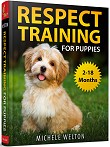 Respect Training For Puppies: 30 seconds to a calm, polite, well-behaved puppy is for puppies 2 to 18 months old. Your puppy will learn the 21 skills that all family dogs need to know. Click here to read for free.
Respect Training For Puppies: 30 seconds to a calm, polite, well-behaved puppy is for puppies 2 to 18 months old. Your puppy will learn the 21 skills that all family dogs need to know. Click here to read for free.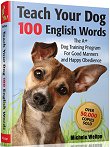 Teach Your Dog 100 English Words is a unique Vocabulary and Respect Training Program that will teach your adult dog to listen to you and do what you say. Click here to read for free.
Teach Your Dog 100 English Words is a unique Vocabulary and Respect Training Program that will teach your adult dog to listen to you and do what you say. Click here to read for free.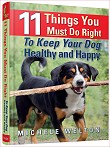 11 Things You Must Do Right To Keep Your Dog Healthy and Happy helps your dog live a longer, healthier life. Get my honest advice about all 11 Things before you bring home your new puppy, because some mistakes with early health care cannot be undone. Click here to read for free.
11 Things You Must Do Right To Keep Your Dog Healthy and Happy helps your dog live a longer, healthier life. Get my honest advice about all 11 Things before you bring home your new puppy, because some mistakes with early health care cannot be undone. Click here to read for free.Related posts you might enjoy



